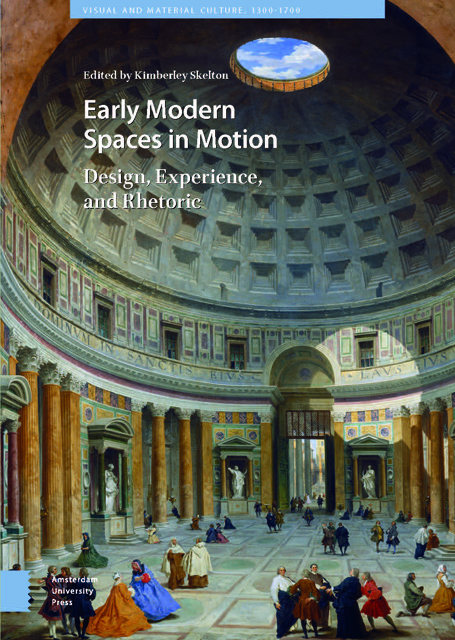Book contents
- Frontmatter
- Table of Contents
- List of Illustrations
- Acknowledgements
- Introduction: Bodies and Buildings in Motion
- 1 Navigating the Palace Underworld : Recreational Space, Pleasure, and Release at the Castello del Buonconsiglio, Trent
- 2 Passages to Fantasy : The Performance of Motion in Celliniâs Fontainebleau Portal and the Galerie François I
- 3 The Catholic Country House in Early Modern England : Motion, Pietyand Hospitality, c. 1580â1640
- 4 Sensory Vibrations and Social Reform at San Michele a Ripa in Rome
- 5 The Rise of the Staircase: Motion in Eighteenth-Century Dutch Domestic Architecture
- 6 Movement through Ruins: Re-experiencing Ancient Baalbek with Jean de la Roque
- 7 A Paper Tour of the Metropolis : The Architecture of Early Modern London in the Royal Magazine
- 8 Libraries in Motion: Forms of Movement in the Early Modern Library (1450-1770)
- Works Cited
- Index
Introduction: Bodies and Buildings in Motion
Published online by Cambridge University Press: 11 January 2023
- Frontmatter
- Table of Contents
- List of Illustrations
- Acknowledgements
- Introduction: Bodies and Buildings in Motion
- 1 Navigating the Palace Underworld : Recreational Space, Pleasure, and Release at the Castello del Buonconsiglio, Trent
- 2 Passages to Fantasy : The Performance of Motion in Celliniâs Fontainebleau Portal and the Galerie François I
- 3 The Catholic Country House in Early Modern England : Motion, Pietyand Hospitality, c. 1580â1640
- 4 Sensory Vibrations and Social Reform at San Michele a Ripa in Rome
- 5 The Rise of the Staircase: Motion in Eighteenth-Century Dutch Domestic Architecture
- 6 Movement through Ruins: Re-experiencing Ancient Baalbek with Jean de la Roque
- 7 A Paper Tour of the Metropolis : The Architecture of Early Modern London in the Royal Magazine
- 8 Libraries in Motion: Forms of Movement in the Early Modern Library (1450-1770)
- Works Cited
- Index
Summary
Abstract
Since antiquity, motion had been a key means of designing and describing the physical environment. During the sixteenth through the eighteenth centuries, however, individuals across Europe increasingly designed, experienced, and discussed a new world of motion – one characterized by continuous, rather than segmented, movement. This chapter examines the shift from segmented to continuous motion in order to establish the architectural and cultural historical context for the following eight essays. It considers how architects and other authors stressed ever more putting individuals in motion through new types of built spaces and through new approaches to architectural treatises and guidebooks, while writers in other discourses encompassing science, medicine, and philosophy debated movements at all scales from the heliocentric universe to vibrating atoms.
Keywords: choreography, motion, human body, building, Baroque
As early eighteenth-century readers perused the first volume of Paul Decker’s Fürstliche Baumeister, oder Architectura civilis, they encountered an unexpected invitation: they were encouraged to imagine moving through a hypothetical princely palace. From the title of ‘Fürstliche Baumeister’, or ‘Princely Master Builder’, they knew that Decker would be offering them advice on good design – advice useful for a ‘master builder’ – and so would have expected the usual outline of design principles followed by various sample designs. These sequences of sample designs assumed a motionless reader who surveyed an overall structure, for each design was placed on a single page or half-page. On a page from the Italian Sebastiano Serlio’s Tutte l’opere d’architettura, et prospettiva of 1584, for instance, it is easy to evaluate the overall designs of two palaces since their facades and plans are aligned; one can compare how windows are placed across the exterior and illuminate the interior (Figure 1). Only authors of guidebooks led readers on tours of buildings to point out notable features and objects, and these buildings were built structures, in contrast to Decker’s hypothetical palace.
From the very first pages of his book, however, Decker suggests that his invitation to motion through a hypothetical palace is an effective, alternative approach to learning about good design. In his letter to the reader, he explains that his volume is the first of five examining building types from churches to hospitals and so implies a sweeping survey of ‘civil architecture’ that would be useful to a court architect.
- Type
- Chapter
- Information
- Early Modern Spaces in MotionDesign, Experience and Rhetoric, pp. 13 - 32Publisher: Amsterdam University PressPrint publication year: 2020



